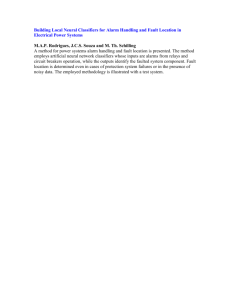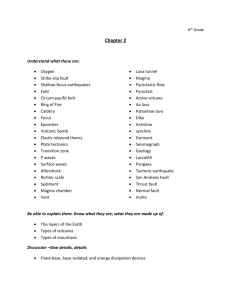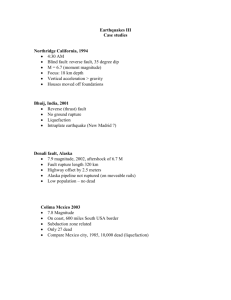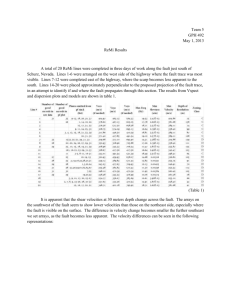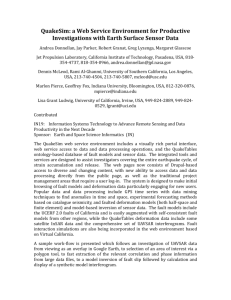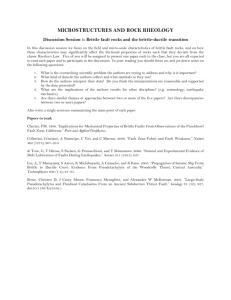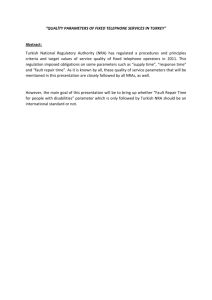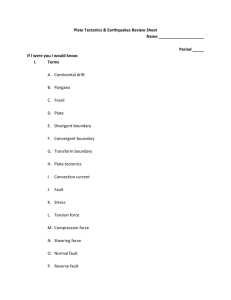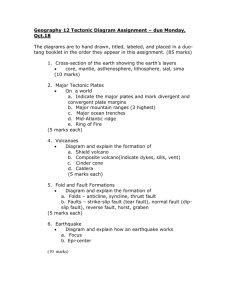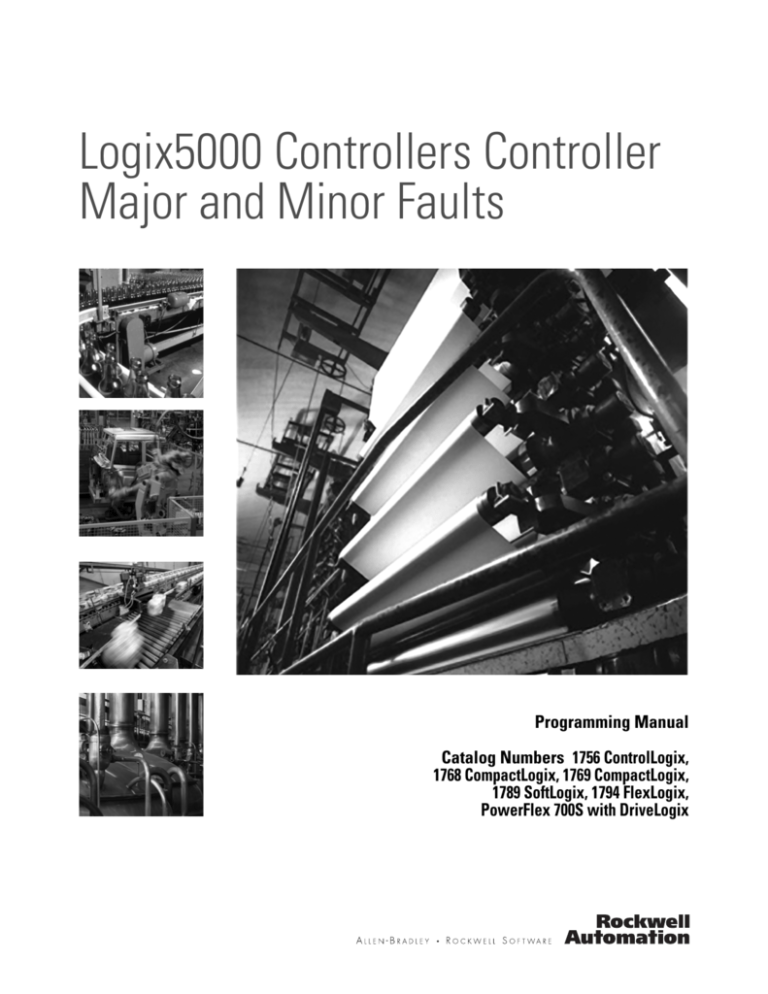
Logix5000 Controllers Controller
Major and Minor Faults
Programming Manual
Catalog Numbers 1756 ControlLogix,
1768 CompactLogix, 1769 CompactLogix,
1789 SoftLogix, 1794 FlexLogix,
PowerFlex 700S with DriveLogix
Important User Information
Solid state equipment has operational characteristics differing from those of electromechanical equipment. Safety Guidelines for the
Application, Installation and Maintenance of Solid State Controls (publication SGI-1.1 available from your local Rockwell Automation sales
office or online at http://literature.rockwellautomation.com) describes some important differences between solid state equipment and hardwired electromechanical devices. Because of this difference, and also because of the wide variety of uses for solid state equipment, all
persons responsible for applying this equipment must satisfy themselves that each intended application of this equipment is acceptable.
In no event will Rockwell Automation, Inc. be responsible or liable for indirect or consequential damages resulting from the use or
application of this equipment.
The examples and diagrams in this manual are included solely for illustrative purposes. Because of the many variables and requirements
associated with any particular installation, Rockwell Automation, Inc. cannot assume responsibility or liability for actual use based on the
examples and diagrams.
No patent liability is assumed by Rockwell Automation, Inc. with respect to use of information, circuits, equipment, or software described in
this manual.
Reproduction of the contents of this manual, in whole or in part, without written permission of Rockwell Automation, Inc., is prohibited.
Throughout this manual, when necessary, we use notes to make you aware of safety considerations.
WARNING
IMPORTANT
ATTENTION
Identifies information about practices or circumstances that can cause an explosion in a
hazardous environment, which may lead to personal injury or death, property damage, or
economic loss.
Identifies information that is critical for successful application and understanding of the product.
Identifies information about practices or circumstances that can lead to personal injury or death,
property damage, or economic loss. Attentions help you identify a hazard, avoid a hazard, and
recognize the consequence
SHOCK HAZARD
Labels may be on or inside the equipment, for example, a drive or motor, to alert people that
dangerous voltage may be present.
BURN HAZARD
Labels may be on or inside the equipment, for example, a drive or motor, to alert people that
surfaces may reach dangerous temperatures.
Allen-Bradley, Rockwell Automation, and TechConnect are trademarks of Rockwell Automation, Inc.
Trademarks not belonging to Rockwell Automation are property of their respective companies.
Summary of Changes
Introduction
The release of this document contains new and updated information. To find
new and updated information, look for change bars, as shown next to this
paragraph.
Updated Information
This document contains the following changes.
Topic
Updated major fault codes
3Publication 1756-PM014B-EN-P - July 2008
Page
Chapter 2
3
Summary of Changes
Notes:
4
Publication 1756-PM014B-EN-P - July 2008
Table of Contents
Preface
Purpose of this Manual . . . . . . . . . . . . . . . . . . . . . . . . . . . . . . . . . . . . . . 7
How to Use this Manual . . . . . . . . . . . . . . . . . . . . . . . . . . . . . . . . . . . . . 7
Chapter 1
Monitor Minor Faults
Introduction . . . . . . . . . . . . . . . . . . . . . . . . . . . . . . . . . . . . . . . . . . . . . . . 9
Minor Fault Codes . . . . . . . . . . . . . . . . . . . . . . . . . . . . . . . . . . . . . . . . . 12
Chapter 2
Handle a Major Fault
5Publication 1756-PM014B-EN-P - July 2008
Introduction . . . . . . . . . . . . . . . . . . . . . . . . . . . . . . . . . . . . . . . . . . . . . . 15
Choose Where to Place the Fault Routine . . . . . . . . . . . . . . . . . . . 15
Create a Fault Routine for a Program . . . . . . . . . . . . . . . . . . . . . . . . . . 16
Create the Routine . . . . . . . . . . . . . . . . . . . . . . . . . . . . . . . . . . . . . . 16
Assign the Routine as the Fault Routine . . . . . . . . . . . . . . . . . . . . 16
Create a Routine for the Controller Fault Handler. . . . . . . . . . . . . . . . 17
Create a Routine for the Power-Up Handler . . . . . . . . . . . . . . . . . . . . 17
Programmatically Clear a Major Fault . . . . . . . . . . . . . . . . . . . . . . . . . . 18
Create a Data Type to Store Fault Information . . . . . . . . . . . . . . . 18
Get the Fault Type and Code . . . . . . . . . . . . . . . . . . . . . . . . . . . . . 19
Check for a Specific Fault . . . . . . . . . . . . . . . . . . . . . . . . . . . . . . . . 19
Clear the Fault . . . . . . . . . . . . . . . . . . . . . . . . . . . . . . . . . . . . . . . . . 20
Clear a Major Fault During Prescan . . . . . . . . . . . . . . . . . . . . . . . . . . . 20
Identify When the Controller is in Prescan . . . . . . . . . . . . . . . . . . 21
Get the Fault Type and Code . . . . . . . . . . . . . . . . . . . . . . . . . . . . . 21
Check for a Specific Fault . . . . . . . . . . . . . . . . . . . . . . . . . . . . . . . . 22
Clear the Fault . . . . . . . . . . . . . . . . . . . . . . . . . . . . . . . . . . . . . . . . . 23
Test a Fault Routine . . . . . . . . . . . . . . . . . . . . . . . . . . . . . . . . . . . . . . . . 23
Create a User-Defined Major Fault . . . . . . . . . . . . . . . . . . . . . . . . . . . . 24
Create a Fault Routine for the Program . . . . . . . . . . . . . . . . . . . . . 25
Configure the Program to Use the Fault Routine . . . . . . . . . . . . . 25
Jump to the Fault Routine. . . . . . . . . . . . . . . . . . . . . . . . . . . . . . . . 26
Major Fault Codes . . . . . . . . . . . . . . . . . . . . . . . . . . . . . . . . . . . . . . . . . 27
5
Table of Contents
6
Publication 1756-PM014B-EN-P - July 2008
Preface
Purpose of this Manual
This manual shows how to monitor and handle major and minor controller
faults. This manual is one of a set of related manuals that show common
procedures for programming and operating Logix5000 controllers. For a
complete list of common procedures manuals, see the Logix 5000 Controllers
Common Procedures Programming Manual, publication 1756-PM001.
The term Logix5000 controller refers to any controller that is based on the
Logix5000 operating system, such as:
· CompactLogix controllers
· ControlLogix controllers
· DriveLogix controllers
· FlexLogix controllers
· SoftLogix5800 controllers
How to Use this Manual
Some text is formatted differently from the rest of the text.
Text that is
Identifies
Italic
the actual name of an item that you Right-click User-Defined …
see on your screen or in an example
Right-click the item that is named
User-Defined.
courier
information that you must supply
based on your application (a
variable)
Right-click
name_of_program …
You must identify the specific program in
your application. Typically, it is a name or
variable that you have defined.
Press [Enter].
Press the Enter key.
enclosed in brackets a keyboard key
7Publication 1756-PM014B-EN-P - July 2008
For example
Means
7
Summary of Changes
Preface
Notes:
8
Publication 1756-PM014B-EN-P - July 2008
Chapter
1
Monitor Minor Faults
To use relay ladder logic to capture information about a minor fault:
Introduction
To check for a
Do this
Periodic task overlap
1. Enter a GSV instructions that gets the FAULTLOG object, MinorFaultBits attribute.
2. Monitor bit 6.
Load from nonvolatile
memory
1. Enter a GSV instructions that gets the FAULTLOG object, MinorFaultBits attribute.
Problem with the serial port
1. Enter a GSV instructions that gets the FAULTLOG object, MinorFaultBits attribute.
2. Monitor bit 7.
2. Monitor bit 9.
Low battery
1. Enter a GSV instructions that gets the FAULTLOG object, MinorFaultBits attribute.
2. Monitor bit 10.
Problem with an instruction
1. Create a user-defined data type that stores the fault information. Name the data type FaultRecord and
assign these members:
Name:
Data Type:
Style:
TimeLow
DINT
Decimal
TimeHigh
DINT
Decimal
Type
INT
Decimal
Code
INT
Decimal
Info
DINT[8]
Hex
2. Create a tag that will store the values of the MinorFaultRecord attribute. Select the data type from
step 1.
3. Monitor S:MINOR.
4. If S:MINOR is on, use a GSV instruction to get the values of the MinorFaultRecord attribute.
5. If you want to detect a minor fault that is caused by another instruction, reset S:MINOR. (S:MINOR
remains set until the end of the scan.)
9Publication 1756-PM014B-EN-P - July 2008
9
Chapter 1
Monitor Minor Faults
This example checks for a low battery warning.
EXAMPLE
Check for a minor fault
Minor_fault_check times for 1 minute (60000 ms) and then automatically restarts itself.
Every minute, minor_fault_check.DN turns on for one scan. When this occurs, the GSV instruction gets the value of the
FAULTLOG object, MinorFaultBits attribute, and stores it in the minor_fault_bits tag. Because the GSV instruction only
executes once every minute, the scan time of most scans is reduced.
If minor_fault_bits.10 is on, then the battery is low.
42373
10
Publication 1756-PM014B-EN-P - July 2008
Monitor Minor Faults
Chapter 1
This example checks for a minor fault that is caused by a specific instruction.
EXAMPLE
Check for a minor fault that is caused by an instruction
Multiply value_a by 1000000 and check for a minor fault, such as a math overflow.
·
·
·
·
To make sure that a previous instruction did not produce the fault, the rung first clears S:MINOR.
The rung then executes the multiply instruction.
If the instruction produces a minor fault, the controller sets S:MINOR.
If S:MINOR is set, the GSV instruction gets information about the fault and resets S:MINOR.
42373
Publication 1756-PM014B-EN-P - July 2008
11
Chapter 1
Monitor Minor Faults
Minor Fault Codes
The type and code correspond to the type and code displayed in these
locations.
· Controller Properties dialog box, Minor Faults tab
· PROGRAM object, MINORFAULTRECORD attribute
Type
Code
Cause
Recovery Method
4
4
An arithmetic overflow occurred in an instruction.
Fix program by examining arithmetic operations (order)
or adjusting values.
4
5
In a GSV/SSV instruction, the specified instance was
not found.
Check the instance name.
4
6
In a GSV/SSV instruction, either:
Check the Class name and Attribute name.
· specified Class name is not supported
· specified Attribute name is not valid
4
7
The GSV/SSV destination tag was too small to hold all
of the data.
Fix the destination so it has enough space.
4
35
PID delta time ≤0.
Adjust the PID delta time so that it is > 0.
4
36
PID setpoint out of range
Adjust the setpoint so that it is within range.
4
51
The LEN value of the string tag is greater than the DATA
size of the string tag.
1. Check that no instruction is writing to the LEN
member of the string tag.
2. In the LEN value, enter the number of characters
that the string contains.
4
52
The output string is larger than the destination.
Create a new string data type that is large enough for
the output string. Use the new string data type as the
data type for the destination.
4
53
The output number is beyond the limits of the
destination data type.
Either:
· Reduce the size of the ASCII value.
· Use a larger data type for the destination.
4
56
The Start or Quantity value is invalid.
1. Check that the Start value is between 1 and the
DATA size of the Source.
2. Check that the Start value plus the Quantity value is
less than or equal to the DATA size of the Source.
4
57
The AHL instruction failed to execute because the serial Either:
port is set to no handshaking.
· Change the Control Line setting of the serial port.
· Delete the AHL instruction.
6
2
Periodic task overlap.
Simplify program(s), or lengthen period, or raise relative
priority, etc.
Periodic task has not completed before it is time to
execute again.
7
49
Project loaded from nonvolatile memory.
9
0
Unknown error while servicing the serial port.
12
Contact Rockwell Automaiton Technical Support.
Publication 1756-PM014B-EN-P - July 2008
Monitor Minor Faults
Chapter 1
Type
Code
Cause
Recovery Method
9
1
The CTS line is not correct for the current configuration. Disconnect and reconnect the serial port cable to
the controller.
Make sure the cable is wired correctly
9
2
Poll list error.
A problem was detected with the DF1 master’s poll list,
such as specifying more stations than the size of the
file, specifying more then 255 stations, trying to index
past the end of the list, or polling the broadcast address
(STN #255).
Check for the following errors in the poll list:
· total number of stations is greater than the space in
the poll list tag
· total number of stations is greater than 255
· current station pointer is greater than the end of the
poll list tag
· a station number greater than 254 was encountered
9
5
DF1 slave poll timeout.
Determine and correct delay for polling.
The poll watchdog has timed out for slave. The master
has not polled this controller in the specified amount of
time.
9
9
Modem contact was lost.
Correct modem connection to the controller.
DCD and/or DSR control lines are not being received in
proper sequence and/or state.
10
10
Battery not detected or needs to be replaced.
Publication 1756-PM014B-EN-P - July 2008
Install new battery.
13
Chapter 1
Monitor Minor Faults
Notes:
14
Publication 1756-PM014B-EN-P - July 2008
Chapter
2
Handle a Major Fault
If a fault condition occurs that is severe enough for the controller to shut
down, the controller generates a major fault and stops the execution of logic.
· Depending on your application, you may not want all major faults to
shut down your entire system.
· In those situations, you can use a fault routine to clear a specific fault
and let at least some of your system continue to operate.
Introduction
EXAMPLE
Use a fault routine
In a system that uses recipe numbers as indirect addresses, a miss-typed number
could produce a major fault, such as type 4, code 20.
To keep the entire system from shutting down, a fault routine clears any
type 4, code 20, major faults.
Choose Where to Place the Fault Routine
A fault routine lets you program logic to take specific action after a fault, such
as clear the fault and resume execution. Where you place the routine depends
on the type of fault that you want to handle:
If you want take specific action/clear the fault when
Do this
Page
Condition
Fault Type
The execution of an instruction faults
4
Create a Fault Routine for a Program
16
Communication with an I/O module fails
3
Create a Routine for the Controller Fault Handler
17
Watchdog time for a task expires
6
While a project is downloading to the
controller, the keyswitch is placed in RUN
8
A motion axis faults
11
The controller powers up in run/remote run
mode
1
Create a Routine for the Power-Up Handler
17
15Publication 1756-PM014B-EN-P - July 2008
15
Chapter 2
Handle a Major Fault
Create a Fault Routine for a Create the Routine
Program
1. Right-click the program and choose New Routine.
2. Define the routine.
Assign the Routine as the Fault Routine
1. Right-click the program and choose Properties.
2. Specify the fault routine.
16
Publication 1756-PM014B-EN-P - July 2008
Handle a Major Fault
Chapter 2
Create a Routine for the
Controller Fault Handler
1. Create a program for the Controller Fault Handler.
2. Create a routine for the program.
3. Configure the routine as the main routine for the program.
Create a Routine for the
Power-Up Handler
The power-up handler is an optional task that executes when the controller
powers up in run/remote run mode. Use the power-up handler when you want
to accomplish either of the following after power is lost and then restored:
To
Do this
Prevent the controller from returning to
run/remote mode
Leave the routine for the Power-Up Handler empty. When power is restored, a major fault
(type 1, code 1) occurs and the controller enters the Faulted mode.
When power is restored, take specific
actions and then resume normal
operation
In the routine for the Power-Up Handler:
1. Clear the major fault (type 1, code 1).
2. Enter the logic for the actions.
1. Create a program for the Power-Up Handler.
2. Create a routine for the program.
3. Configure the routine as the main routine for the program.
Publication 1756-PM014B-EN-P - July 2008
17
Chapter 2
Handle a Major Fault
Programmatically Clear a
Major Fault
To clear a major fault that occurs during the execution of your project,
complete these actions in the appropriate routine.
· Create a Data Type to Store Fault Information
· Get the Fault Type and Code
· Check for a Specific Fault
· Clear the Fault
Create a Data Type to Store Fault Information
Logix5000 controllers store system information in objects. Unlike PLC-5 or
SLC 500 controllers, there is no status file.
· To access system information, you use a Get System Value (GSV) or Set
System Value (SSV) instruction.
· For status information about a program, you access the PROGRAM
object.
· For fault information, you access these attribute of the PROGRAM
object.
Attribute
Data Type
Instruction
Description
MajorFaultRecord
DINT[11]
GSV
Records major faults for this program
SSV
Specify the program name to determine which PROGRAM object
you want. (Or specify THIS to access the PROGRAM object for the
program that contains the GSV or SSV instruction.)
To simplify access to the MajorFaultRecord attribute, create this user-defined
data type.
To create a new data type:
+ Controller Your_Project
+ Tasks
+ Motion Groups
Trends
− Data Types
User-Defined
Right-click and choose New Data
Type.
18
Data Type: FAULTRECORD
Name
FAULTRECORD
Description
Stores the MajorFaultRecord attribute or MinorFaultRecord
attribute of the PROGRAM object.
Members
Name
Data Type
Style
Description
Time_Low
DINT
Decimal
lower 32 bits of the fault timestamp value
Time_High
DINT
Decimal
upper 32 bits of the fault timestamp value
Type
INT
Decimal
fault type (program, I/O, etc)
Code
INT
Decimal
unique code for the fault
Info
DINT[8]
Hex
fault specific information
Publication 1756-PM014B-EN-P - July 2008
Handle a Major Fault
Chapter 2
Get the Fault Type and Code
42372
1. The GSV instruction accesses the MAJORFAULTRECORD attribute
of this program. This attribute stores information about the fault.
2. The GSV instruction stores the fault information in the
major_fault_record tag (of type FAULTRECORD). When you enter a
tag that is based on a structure, enter the first member of the tag.
Check for a Specific Fault
1
1.
2.
Equal
Source A major_fault_record.Type
0
Source B
fault_type
Equal
Source A major_fault_record.Code
0
Source B
fault_code
MOV
MOV
Move
Source
0
Dest major_fault_record.Type
0
2
3.
Move
Source
Dest major_fault_record
SSV
Set system value
CIP Object class
PR
CIP Object name
42372
Attribute name
MAJORFAULTR
j
f l
d i
4.
1. The first EQU instruction checks for a specific type of fault, such as
program, I/O. In Source B, enter the value for the type of fault that you
want to clear.
2. The second EQU instruction checks for a specific fault code. In
Source B, enter the value for the code that you want to clear.
3. The first CLR instruction sets to zero the value of the fault type in the
major_fault_record tag.
4. The second CLR instruction sets to zero the value of the fault code in
the major_fault_record tag.
Publication 1756-PM014B-EN-P - July 2008
19
Chapter 2
Handle a Major Fault
Clear the Fault
42372
1. The SSV instruction writes new values to the MAJORFAULTRECORD
attribute of this program.
2. The SSV instruction writes the values contained in the
major_fault_record tag. Since the Type and Code member are set to
zero, the fault clears and the controller resumes execution.
Clear a Major Fault During
Prescan
If the controller faults immediately after you switch it to the Run mode, then
examine the prescan operation for the fault. Depending on the revision of
your controller, an array subscript that is beyond the range of the array (out of
range) during prescan may or may not produce a fault.
If your controller is
revision
Then
11.x or earlier
During prescan, an array subscript that is beyond the range of the array (out of range)
produces a major fault.
12.x
See the release notes for the firmware of your controller.
13.0 or later
During prescan, the controller automatically clears any faults due to an array subscript that is
beyond the range of the array (out of range).
To clear a major fault that occurs during prescan:
·
·
·
·
Identify When the Controller is in Prescan
Get the Fault Type and Code
Check for a Specific Fault
Clear the Fault
IMPORTANT
20
It is a good programming practice to check for a specific fault
before clearing the fault.
Publication 1756-PM014B-EN-P - July 2008
Handle a Major Fault
Chapter 2
Identify When the Controller is in Prescan
In the main routine of your program, enter this rung as the first rung in the
main routine of the program.
43063
The fault routine of this program uses the status of this bit to determine if the
fault occurred during prescan or normal scan of the logic.
· During prescan, this bit is off. (During prescan, the controller resets
all bits that are referenced by OTE instructions.)
· Once the controller begins to execute the logic, the CPU_scanning
bit is always on.
Get the Fault Type and Code
Enter this rung in the fault routine for the program.
43064
1. The GSV instruction accesses the MAJORFAULTRECORD attribute
of this program. This attribute stores information about the fault.
2. The GSV instruction stores the fault information in the
major_fault_record (of type FAULTRECORD) tag. When you enter a
tag that is based on a structure, enter the first member of the tag.
Publication 1756-PM014B-EN-P - July 2008
21
Chapter 2
Handle a Major Fault
Check for a Specific Fault
Enter this rung in the fault routine for the program.
1.
2.
3.
43064
4.
5.
1. During prescan the bits of all OTE instructions are off and this
instruction is true. Once the controller begins to execute the logic, this
instruction is always false.
2. The first EQU instruction checks for a fault of type 4, which means that
an instruction in this program caused the fault.
3. The second EQU instruction checks for a fault of code 20, which means
that either an array subscript is too large, or a POS or LEN value of a
CONTROL structure is invalid.
4. The first CLR instruction sets to zero the value of the fault type in the
major_fault_record tag.
5. The second CLR instruction sets to zero the value of the fault code in
the major_fault_record tag.
22
Publication 1756-PM014B-EN-P - July 2008
Handle a Major Fault
Chapter 2
Clear the Fault
Enter this rung in the fault routine for the program.
43064
1. During prescan the bits of all OTE instructions are off and this
instruction is true. Once the controller begins to execute the logic, this
instruction is always false.
2. The SSV instruction writes new values to the MAJORFAULTRECORD
attribute of this program.
3. The SSV instruction writes the values contained in the
major_fault_record tag. Since the Type and Code member are set to
zero, the fault clears and the controller resumes execution.
Test a Fault Routine
You can use a JSR instruction to test the fault routine of a program without
creating an error (simulate a fault).
1. Create a BOOL tag that you will use to initiate the fault.
2. In the main routine or a subroutine of the program, enter this rung:
Publication 1756-PM014B-EN-P - July 2008
where:
is the:
aaa
tag that you will use to initiate the fault
bbb
fault routine of the program
23
Chapter 2
Handle a Major Fault
3. To simulate a fault, set the input condition.
EXAMPLE
Test a fault routine
When test_fault_routine is on, a major fault occurs and the controller executes
Fault_Routine.
Create a User-Defined
Major Fault
If you want to suspend (shut down) the controller based on conditions in your
application, create a user-defined major fault. With a user-defined major fault:
· The fault type = 4.
· You define a value for the fault code. Choose a value between 990 to
999. These codes are reserved for user-defined faults.
· The controller handles the fault the same as other major faults:
– The controller changes to the faulted mode (major fault) and stops
executing the logic.
– Outputs are set to their configured state or value for faulted mode.
EXAMPLE
User-defined major fault
When Tag_1.0 = 1, produce a major fault and generate a fault
code of 999.
To create a user-defined major fault:
· Create a Fault Routine for the Program
· Configure the Program to Use the Fault Routine
· Jump to the Fault Routine
24
Publication 1756-PM014B-EN-P - July 2008
Handle a Major Fault
Chapter 2
Create a Fault Routine for the Program
Does a fault routine already exist for the program?
If
Then
Yes
Go to “Jump to the Fault Routine“on page 26
No
Create a fault routine for the program:
1. In the controller organizer, right-click the program and choose
New Routine.
2. In the name box, type a name for the fault routine.
3. From the Type drop-down list, choose Ladder.
4. Click OK.
Configure the Program to Use the Fault Routine
1. In the controller organizer, right-click the program and choose
New Routine.
2. Select the Configuration tab.
3. From the Fault drop-down list, choose the fault routine.
4. Click OK.
Publication 1756-PM014B-EN-P - July 2008
25
Chapter 2
Handle a Major Fault
Jump to the Fault Routine
In the main routine of the program, enter this rung:
conditions when the
controller should shut
down
EXAMPLE
Where
Is
Fault_Routine
name of the fault routine for the program
999
value for the fault code
Create a User-Defined Major Fault
When Tag_1.0 = 1, execution jumps to name_of_fault_routine. A major fault occurs and the controller enters the faulted
mode. Outputs go to the faulted state. The Controller Properties dialog box, Major Faults tab, displays the code 999.
26
Publication 1756-PM014B-EN-P - July 2008
Handle a Major Fault
Major Fault Codes
Chapter 2
The type and code correspond to the type and code displayed in these
locations.
· Controller Properties dialog box, Major Faults tab
· PROGRAM object, MAJORFAULTRECORD attribute
Type
Code
Cause
Recovery Method
1
1
The controller powered on in Run mode.
Execute the power-loss handler.
1
15
1
60
• A 1769 power supply is connected directly
to the controller’s 1769 CompactBus, with
an invalid configuration.
• Remove the power supply from the 1769 CompactBus and cycle
power to the system.
• The 1768 power supply powering the
controller has failed.
• Replace the power supply.
For a controller with no CompactFlash card
installed, the controller:
• detected a non-recoverable fault
• cleared the project from memory
1
61
For a controller with a CompactFlash card
installed, the controller:
• detected a non-recoverable fault
• wrote diagnostic information to the
CompactFlash card
1. Clear the fault.
2. Download the project.
3. Change to remote run/run mode.
If the problem persists:
1. Before you cycle power to the controller, record the state of the
OK and RS232 LEDs.
2. Contact Rockwell Automation support. See the back of this
publication.
1. Clear the fault.
2. Download the project.
3. Change to remote run/run mode.
If the problem persists, contact Rockwell Automation support. See
the back of this publication.
• cleared the project from memory
3
16
A required I/O module connection failed.
Check that the I/O module is in the chassis. Check electronic
keying requirements.
View the controller properties Major Fault tab and the module
properties Connection tab for more information about the fault.
3
20
Possible problem with the ControlBus chassis.
Not recoverable - replace the chassis.
3
23
At least one required connection was not
established before going to Run mode.
Wait for the controller I/O light to turn green before changing to
Run mode.
4
16
Unknown instruction encountered.
Remove the unknown instruction. This probably happened due to a
program conversion process.
4
20
Array subscript too big, control structure .POS
or .LEN is invalid.
Adjust the value to be within the valid range. Don’t exceed the
array size or go beyond dimensions defined.
4
21
Control structure .LEN or .POS < 0.
Adjust the value so it is > 0.
4
31
The Parameters of the JSR instruction do not
match those of the associated SBR or RET
instruction.
Pass the appropriate number of Parameters. If too many
Parameters are passed, the extra ones are ignored without any
error.
4
34
A timer instruction has a negative preset or
accumulated value.
Fix the program to not load a negative value into timer preset or
accumulated value.
4
42
JMP to a label that did not exist or was
deleted.
Correct the JMP target or add the missing label.
Publication 1756-PM014B-EN-P - July 2008
27
Chapter 2
Handle a Major Fault
Type
Code
Cause
Recovery Method
4
82
A sequential function chart (SFC) called a
subroutine and the subroutine tried to jump
back to the calling SFC. Occurs when the SFC
uses either a JSR or FOR instruction to call the
subroutine.
Remove the jump back to the calling SFC.
4
83
The data tested was not inside the
required limits.
Modify value to be within limits.
4
84
Stack overflow.
Reduce the subroutine nesting levels or the number of Parameters
passed.
4
89
In a SFR instruction, the target routine does not
contain the target step.
Correct the SFR target or add the missing step.
6
1
Task watchdog expired.
7
40
Store to nonvolatile memory failed.
Increase the task watchdog, shorten the execution time, make the
priority of this task “higher,” simplify higher priority tasks, or move
User task has not completed in specified period some code to another controller.
of time. A program error caused an infinite loop,
or the program is too complex to execute as
quickly as specified, or a higher priority task is
keeping this task from finishing.
1. Try again to store the project to nonvolatile memory.
2. If the project fails to store to nonvolatile memory, replace the
memory board.
7
41
Load from nonvolatile memory failed due to
controller type mismatch.
Change to a controller of the correct type or download the project
and store it on the CompactFlash card.
7
42
Load from nonvolatile memory failed because
the firmware revision of the project in
nonvolatile memory does not match the
firmware revision of the controller.
Update the controller firmware to the same revision level as the
project that is in nonvolatile memory.
7
43
Load from nonvolatile memory failed due to bad Contact Rockwell Automation support. See the back of this
publication.
checksum.
7
44
Failed to restore processor memory.
Contact Rockwell Automation support. See the back of this
publication.
8
1
Attempted to place controller in Run mode with
keyswitch during download.
Wait for the download to complete and clear fault.
11
1
Actual position has exceeded positive
overtravel limit.
Move axis in negative direction until position is within overtravel
limit and then execute Motion Axis Fault Reset.
11
2
Actual position has exceeded negative
overtravel limit.
Move axis in positive direction until position is within overtravel
limit and then execute Motion Axis Fault Reset.
11
3
Actual position has exceeded position error
tolerance.
Move the position within tolerance and then execute Motion Axis
Fault Reset.
11
4
Encoder channel A, B, or Z connection is broken. Reconnect the encoder channel then execute Motion Axis Fault
Reset.
11
5
Encoder noise event detected or the encoder
signals are not in quadrature.
Fix encoder cabling then execute Motion Axis Fault Reset.
11
6
Drive Fault input was activated.
Clear Drive Fault then execute Motion Axis Fault Reset.
28
Publication 1756-PM014B-EN-P - July 2008
Handle a Major Fault
Chapter 2
Type
Code
Cause
Recovery Method
11
7
Synchronous connection incurred a failure.
First execute Motion Axis Fault Reset. If that doesn’t work, pull
servo module out and plug back in. If all else fails replace servo
module.
11
8
Servo module has detected a serious
hardware fault.
Replace the module.
11
9
Configuration fault has occurred.
See the AttributeErrorCode or AttributeErrorID axis tag fields to
identify which attribute was rejected and why.
The motion module or drive has rejected the
update of one of the axis attributes.
11
10
Motor fault has occurred.
See the DriveFaults axis tag for more information.
11
11
Motor thermal fault has occurred.
See the DriveFaults axis tag for more information.
11
12
Drive thermal fault has occurred.
See the DriveFaults axis tag for more information.
11
13
SERCOS ring fault has occurred.
Verify the integrity of the SERCOS fiber-optic ring network and the
devices on it.
11
14
Drive enable input fault has occurred.
Re-enable the drive enable input and clear the fault.
11
15
Drive phase loss fault has occurred.
Restore full power connection to the drive and clear the fault.
11
16
Drive guard fault has occurred.
See the GuardFaults axis tag for more information.
11
32
The motion task has experienced an overlap.
The group’s course update rate is too high to maintain correct
operation. Clear the group fault tag, raise the group’s update rate,
and then clear the major fault.
Publication 1756-PM014B-EN-P - July 2008
29
Chapter 2
Handle a Major Fault
Notes:
30
Publication 1756-PM014B-EN-P - July 2008
Rockwell Automation
Support
Rockwell Automation provides technical information on the Web to assist you in
using its products. At http://support.rockwellautomation.com, you can find technical
manuals, a knowledge base of FAQs, technical and application notes, sample code and
links to software service packs, and a MySupport feature that you can customize to
make the best use of these tools.
For an additional level of technical phone support for installation, configuration, and
troubleshooting, we offer TechConnect support programs. For more information,
contact your local distributor or Rockwell Automation representative, or visit
http://support.rockwellautomation.com.
Installation Assistance
If you experience a problem within the first 24 hours of installation, please review the
information that's contained in this manual. You can also contact a special Customer
Support number for initial help in getting your product up and running.
United States
1.440.646.3434
Monday – Friday, 8am – 5pm EST
Outside United
States
Please contact your local Rockwell Automation representative for any
technical support issues.
New Product Satisfaction Return
Rockwell Automation tests all of its products to ensure that they are fully operational
when shipped from the manufacturing facility. However, if your product is not
functioning and needs to be returned, follow these procedures.
United States
Contact your distributor. You must provide a Customer Support case
number (call the phone number above to obtain one) to your distributor
in order to complete the return process.
Outside United
States
Please contact your local Rockwell Automation representative for the
return procedure.
Publication 1756-PM014B-EN-P - July 2008 32
Supersedes Publication 1756-PM014A-EN-P - July 2007
Copyright © 2008 Rockwell Automation, Inc. All rights reserved. Printed in the U.S.A.

